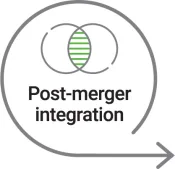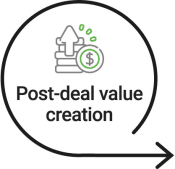
Evolving from surviving to thriving in hospitality and leisure
300+
Erfahrene M&A-Expert:innen
430+
Globale M&A-Transaktionen in den letzten drei Jahren
175
Due Diligence Projekte im Jahr 2022
Fokus auf Wertschöpfung:
Wir erzielen schnell und entschlossen nachhaltige Ergebnisse gemeinsam mit unseren Klienten. Wir identifizieren, transformieren und schöpfen das volle Wertpotenzial aus, indem wir uns klar auf messbare Resultate konzentrieren.
Unabhängige Beratung entlang der gesamten M&A-Wertschöpfungskette:
Unsere Projekte beginnen oftmals mit der Evaluierung der strategischen Optionen. Führt diese schließlich zu einer M&A-Transaktion, umfasst unser M&A Offering vornehmlich die Bereiche Due Diligence, Carve-Outs, M&A Lead Advisory und Post-Merger-Integration (PMI). Die umfangreiche funktionale Expertise in diesen Bereichen ermöglicht es uns, unseren Kunden auf der Käufer- und Verkäuferseite maßgeschneiderte Lösungen für komplexe Problemstellungen anzubieten.
Industrieerfahrung:
Unsere Senior-Teams verfügen über langjährige, praxisnahe Branchenerfahrung und Expertise in den komplexesten M&A-Szenarien – als Vorstandsmitglied bis hin zu operativen Management-Rollen.
Unternehmerische Mentalität:
Wir kombinieren operative Umsetzungsstärke in der Hebung von EBITDA- und Cashflow-Verbesserungen mit der Erfahrung in der Durchführung von Transaktionen auf der Käufer- und Verkäuferseite – mit dem Ziel, Unternehmenswerte zu schaffen, zu schützen und wiederherzustellen.
Globaler „One Firm“-Ansatz:
Wir bieten eine umfassende, länderübergreifende und integrierte Palette von Fachkenntnissen, die sich auf unser finanzielles, operatives und digitales Fachwissen stützt – immer zugeschnitten auf Ihre spezifischen Bedürfnisse.
Spezialisierte Erfahrung:
Unser breit gefächertes M&A-Angebot wird durch herausragende Fachkompetenzen in den Bereichen Forensik, Antitrust, Interimsmanagement, Global Investigations und Rechtsstreitigkeiten sowie ESG-Beratung flankiert.
Unser M&A-Team in DACH steht dabei für einen schnellen Prozess mit möglichst wenigen Unterbrechungen für Käufer und Verkäufer. Dies führt zu einem höheren Transaktionswert und größeren Erträgen in allen Phasen des Business Life Cycles.






Learn more about PMI success factor insights from business leaders: